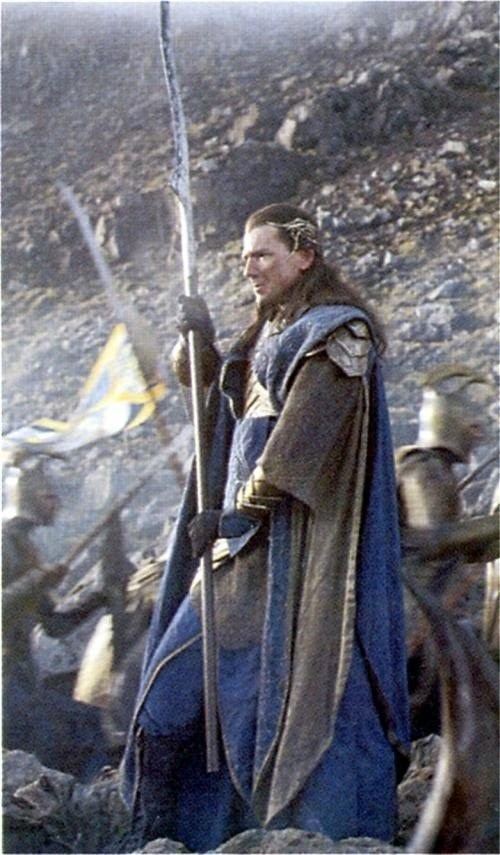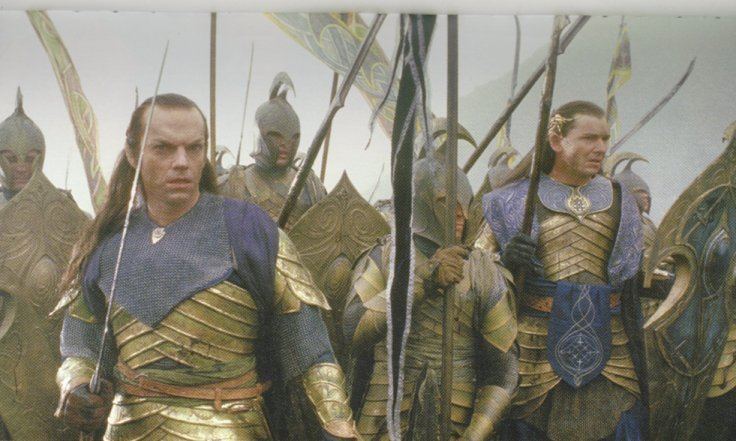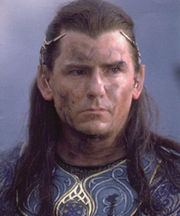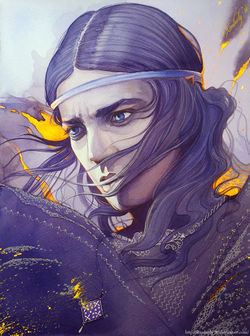Race Elves Ethnicity Noldor Has possessed Narya | Species Elf Weapon Aeglos, Narya, Vilya | |
 | ||
Title King of Lindon, High King of the Elves of the West Similar | ||
Lego lord of the rings walkthrough characters 16 gil galad
Ereinion Gil-galad ([eˈreɪnjon ˈɡilɡalad]) is a fictional Elf in J. R. R. Tolkien's Middle-earth legendarium. He is mentioned in The Lord of the Rings and The Silmarillion.
Contents
- Lego lord of the rings walkthrough characters 16 gil galad
- Games workshop lord of the rings ereinion gil galad with display base
- Character overview
- Literature
- Adaptations
- Concept and creation
- References

Games workshop lord of the rings ereinion gil galad with display base
Character overview
Ereinion Gil-galad was the last High King of the Noldor in Middle-earth.

In early texts, Gil-galad was the son of Fingon the Valiant, son of Fingolfin, son of Finwë, first High King of the Noldor. It is through this descent that his High Kingship of the Noldor is explained, as all of them had previously held the title, and it also perhaps explains his original name Ereinion (which means "Scion of Kings").

Other sources and versions of the text however, indicate that Gil-galad was the son of Orodreth of the House of Finarfin, and his name became Finellach Gil-galad. This would make him grandson of Angrod, the brother of Finrod Felagund, Aegnor and Galadriel.
His name in Tolkien's invented languages of Quenya and Sindarin was Artanáro and Rodnor, respectively, but he was best known as Gil-galad ("Star of Radiance") and his epessë (honorary title) Ereinion, meaning "Scion of Kings".
Literature
Gil-galad was the last of the High Kings of the Noldor-in-Exile in Middle-earth. An Elf of the House of Finwë, he was named High King of the Noldor-in-Exile in Beleriand after the fall of Gondolin and the death of the previous High King, Turgon.
The early history of Gil-galad is somewhat obscure, as Tolkien himself repeatedly changed his mind about who exactly Gil-galad was, and how to fit him into the already existing history of the First Age (see concept and creation, below). Gil-galad was certainly born in Beleriand at some point during the First Age. He was perhaps at some point sent to live in the Falas with Círdan the Shipwright, but this is unclear; certainly after the fall of Nargothrond he was living on the Isle of Balar with Círdan, and became the last High King of the Noldor following the fall of Gondolin and the death of Turgon. Gil-galad, despite his long life (he was born during the First Age and lived through almost the entirety of the Second), was not known to have a wife, nor any children. Due to this, and the fact that there were few Noldor remaining in Middle-earth, the title of High King of the Noldor in Exile ended with his death.
After the War of Wrath and the end of the First Age, Gil-galad founded a realm in the coastal region of Lindon along the shores of Belegaer, the Great Sea. At its height, his realm extended eastward as far as the Misty Mountains, though most of the Eldar remained in Lindon and in Elrond's refuge of Rivendell.
According to The Fellowship of the Ring, Gil-galad was the first of the Eldar to mistrust a stranger calling himself Annatar, and forbade him from entering Lindon. His mistrust was well founded, for it was soon learned that Annatar was in fact Sauron. After Sauron forged the One Ring, Gil-galad was given one of the Three Elven Rings: Vilya, the Ring of Air (and most probably also Narya, the Ring of Fire). Just before Gil-galad's death, Elrond was given Vilya for safekeeping (and Narya was given to Círdan).
During most of the Second Age, Gil-galad enjoyed the friendship of the Númenóreans. This proved very useful as during the War of the Elves and Sauron; a great Númenórean force under the command of their king Tar-Minastir helped Gil-galad destroy Sauron's armies.
After the Downfall of Númenor and the establishment by the Elendili of the Dúnadan kingdoms in exile, there was peace in Middle-earth. In the Age's closing years, however, Sauron reappeared with a newly formed army and a war against the kingdom of Gondor, closest to his old home of Mordor. Gil-galad then formed the Last Alliance of Elves and Men with Elendil, High King of the Dúnedain-in-Exile, The armies of Elves and Men, victorious after the Battle of Dagorlad, entered Mordor and laid siege to Barad-dûr.
At the end of the siege, Sauron finally came forth and fought hand-to hand against Gil-galad and Elendil on the slopes of Mount Doom, but the Dark Lord proved too strong and slew them both. A record left by Isildur in Minas Tirith implies that Sauron himself slew Gil-galad with the heat of his bare hands. Recalling the encounter at the great Council at Rivendell before the Fellowship took the One Ring south, Elrond said that only he and Círdan stood by Gil-galad in that last mortal contest.
Gil-galad's spear was named Aiglos or Aeglos, meaning "snow-point" or "snow-thorn" or more commonly "icicle" (aeg: sharp, pointed; los: snow) because when orcs saw his spear, they would recognize it by its reputation to bring a cold death to them. Elrond said that at the battle of Dagorlad, "we had the mastery: for the Spear of Gil-galad and the Sword of Elendil, Aiglos and Narsil, none could withstand."
Adaptations
In the Lord of the Rings film trilogy by Peter Jackson, Gil-galad is portrayed by actor Mark Ferguson and appears very briefly in The Fellowship of the Ring during the opening prologue sequence, however for the most part Elrond is considered the Elves' commander as he is giving orders. Gil-galad is never mentioned by name in any of the films, although he is mentioned in the behind-the-scenes documentaries included with the Extended Edition DVD of The Fellowship of the Ring and is also listed in the credits. He also appears as an unlockable character in the videogame Lego Lord of the Rings, and is found in the vicinity of Mount Doom.
The Lay of Gil-galad was set to music in the 1981 BBC Radio 4 dramatisation, The Lord of the Rings, composed by Stephen Oliver.
Concept and creation
Gil-galad was originally, and briefly, conceived as a descendant of Fëanor.
Later, and through the writing of The Lord of the Rings, he was considered a son of Finrod Felagund, until Tolkien decided that Felagund was unmarried and childless.
A marginal note by Tolkien from around this time (the late 1950s) suggested that Gil-galad might be the son of Fingon. This suggestion was taken up by Tolkien's son and literary executor Christopher Tolkien in the published version of The Silmarillion, which states that Gil-galad is the son of Fingon. After the Dagor Bragollach and the ruin of Beleriand which results in the death of his grandfather Fingolfin, then High King of the Noldor, Fingon becomes the High King and sends a young Gil-galad to the Havens of the Falas under Círdan. This idea of Gil-galad being sent to the Havens was derived from material which the elder Tolkien had written at the time when he saw Gil-galad as the son of Finrod. After the disaster of the Nírnaeth Arnoediad, the title passes to Fingon's brother Turgon. Morgoth assaults the Falathrim in great force after that battle but Círdan and Gil-galad manage to flee in their ships to the Isle of Balar. When tidings come to Balar about the sack of Gondolin and the death of Turgon, Gil-galad becomes the King. Gil-galad's name in the chapter "Aldarion and Erendis" in the Unfinished Tales was also changed by the younger Tolkien in order to keep consistency with the published version of The Silmarillion. — in the original version of that work he was noted as a son of Finrod. Christopher later stated in The Peoples of Middle-earth that this decision to make Gil-galad a son of Fingon was an editorial mistake on his part, and did not represent his father's conception of the character. He suggested that it would have been better to have left Gil-galad's parentage obscure.
Tolkien's final decision for Gil-galad's parentage appears to have been that he was a son of Orodreth, who was at the same time changed from being a son of Finarfin to a son of Angrod. This conception, however, was never incorporated into the written stories of The Silmarillion, and aspects of it — notably the downgrading of Orodreth into a son of Angrod — would have required considerable reworking of the existing text.
